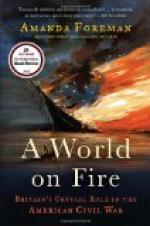Buckingham, one-time member of Parliament, wrote nine volumes of such description. His work is a storehouse of fact, useful to this day to the American historical student[18]. George Combe, philosopher and phrenologist, studied especially social institutions[19]. Joseph Sturge, philanthropist and abolitionist, made a tour, under the guidance of the poet Whittier, through the Northern and Eastern States[20]. Featherstonaugh, a scientist and civil engineer, described the Southern slave states, in terms completely at variance with those of Sturge[21]. Kennedy, traveller in Texas, and later British consul at Galveston, and Warburton, a traveller who came to the United States by way of Canada, an unusual approach, were both frankly startled, the latter professedly alarmed, at the evidences of power in America[22]. Amazed at the energy, growth and prosperity of the country and alarmed at the anti-British feeling he found in New York City, Warburton wrote that “they [Americans] only wait for matured power to apply the incendiary torch of Republicanism to the nations of Europe[23].” Soon after this was written there began, in 1848, that great tide of Irish emigration to America which heavily reinforced the anti-British attitude of the City of New York, and largely changed its character.
Did books dilating upon the expanding power of America reflect British public opinion, or did they create it? It is difficult to estimate such matters. Certainly it is not uninteresting that these books coincided in point of time with a British governmental attitude of opposition, though on peaceful lines, to the development of American power, and to the adoption to the point of faith, by British commercial classes, of free trade as opposed to the American protective system. But governing classes were not the British public, and to the great unenfranchised mass, finding voice through the writings of a few leaders, the prosperity of America made a powerful appeal. Radical democracy was again beginning to make its plea in Britain. In 1849 there was published a study of the United States, more careful and exact than any previous to Bryce’s great work, and lauding American political institutions. This was Mackay’s “Western World,” and that there was a public eager for such estimate is evidenced by the fact that the book went through four British editions in 1850[24]. At the end of the decade, then, there appeared once more a vigorous champion of the cause of British democracy, comparing the results of “government by the wise” with alleged mob rule. Mackay wrote:
“Society in America started from the point to which society in Europe is only yet finding. The equality of men is, to this moment, its corner-stone ... that which develops itself as the sympathy of class, becomes in America the general sentiment of society.... We present an imposing front to the world; but let us tear the picture and look at the canvas. One out of every seven of us is a pauper. Every six




